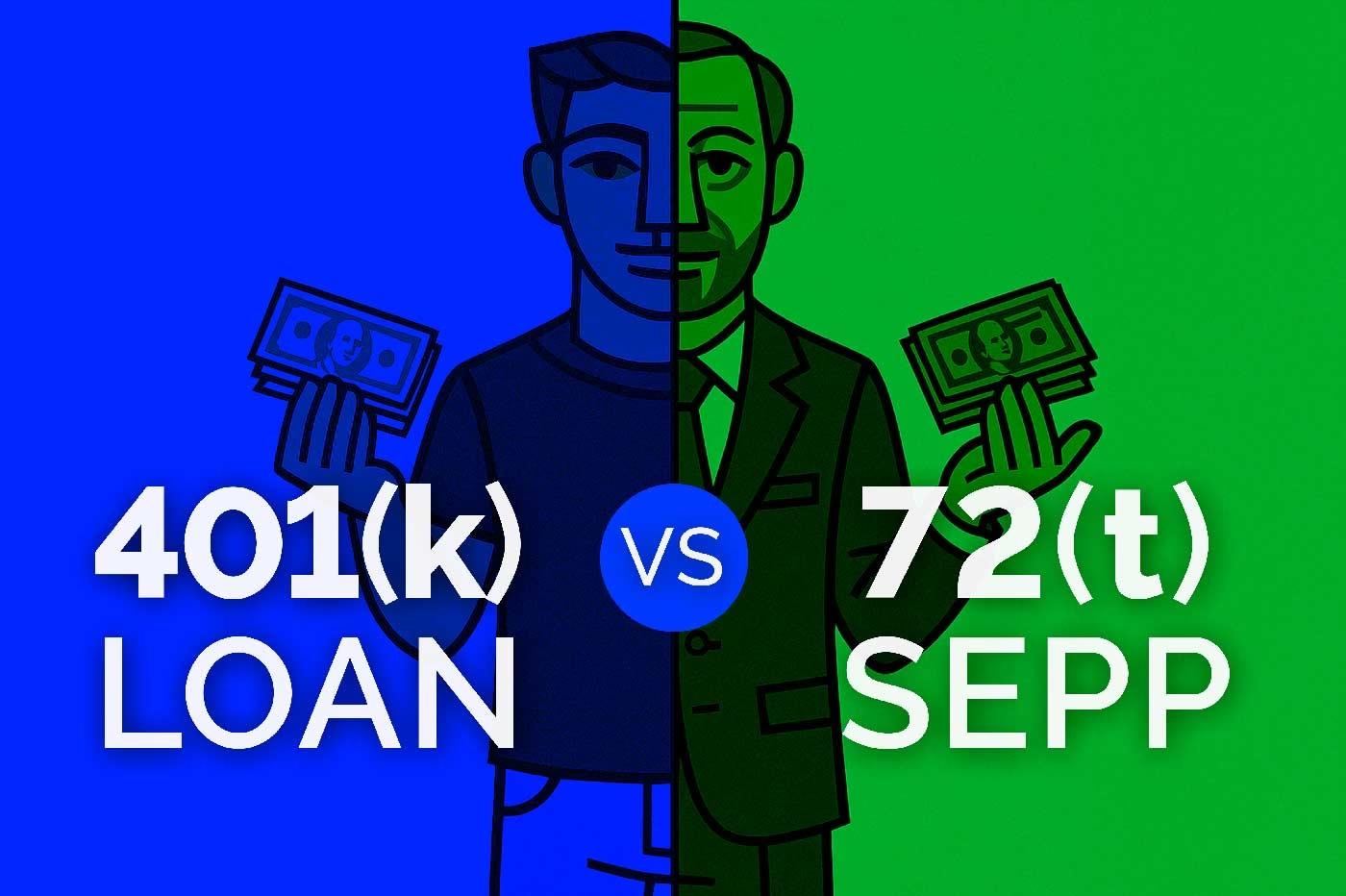If you’re in your 50s, you can probably feel retirement just around the corner. Maybe you’re planning a big home renovation, helping a child through college, or even thinking about stepping away from work a little earlier than you first imagined. But then reality hits: most of your money is tied up in retirement accounts, and dipping into those funds before age 59½ usually means a painful 10% penalty—on top of income taxes.
That leaves you at a financial crossroads. Do you borrow from your retirement savings with a 401(k) loan, or commit to the IRS-approved but rigid 72(t) SEPP (Substantially Equal Periodic Payments) plan? Both give you a way to access money without triggering the early withdrawal penalty, but they work in very different ways—and both come with trade-offs.
This guide breaks down how 401(k) loans and 72(t) SEPPs work, their pros and cons, and when each might make sense. By the end, you’ll have a clearer picture of which early retirement withdrawal strategy could align with your goals.
Table of Contents
Part I: The 401(k) Loan – Borrowing from Yourself
How a 401(k) Loan Works
A 401(k) loan is exactly what it sounds like—you’re borrowing from your own retirement savings. The cool part is that you’re technically paying yourself back with interest. Here’s how it usually works:
- You can borrow up to the lesser of $50,000 or 50% of your vested balance, with a $10,000 minimum exception. The $50,000 limit is reduced by the highest outstanding loan balance you had in the past 12 months.
- Repayments are typically spread out over five years, although a longer repayment term is allowed if you’re buying a primary home. Payments must be made at least quarterly and usually come straight out of your paycheck.
On the surface, this looks like an easy win. You don’t need to apply for credit, your credit score isn’t affected, and the “lender” is—you.
The Pros of a 401(k) Loan
Let’s be fair—there are definitely benefits here:
- No credit check: Approval is almost automatic.
- Interest goes back to you: Instead of sending money to a bank, you pay yourself interest.
- Flexibility: You can repay early without penalties.
- Avoids taxes and penalties (if repaid): Because it’s a loan, not a withdrawal, the IRS doesn’t treat it as taxable income—unless you default.
For short-term needs, 401(k) loans can be an attractive option.
The Cons and Risks of a 401(k) Loan
But don’t get too comfortable. There are serious downsides:
- The opportunity cost: The biggest issue is that the money you borrow is no longer invested. Imagine borrowing $40,000 right before a five-year market upswing. While your account grows, your loaned funds sit idle. That lost compounding could add up to tens of thousands of dollars by retirement.
- The “default” trap: If you leave your job—whether voluntarily or not—plans often “offset” the loan (reduce your account balance by the unpaid amount). If you can’t roll over that offset, it becomes a taxable distribution, subject to income taxes and the 10% penalty if you’re under 59½. For Qualified Plan Loan Offsets (separation or plan termination), you may have until your tax-filing deadline (with extensions) to roll it over.
- Double taxation of interest: The loan principal goes back untaxed, but the interest is repaid with after-tax dollars, and then taxed again when you withdraw in retirement.
- Reduced contributions: Many people pause or reduce their contributions while paying back a loan, which further hampers long-term growth.
Bottom line: a 401(k) loan may solve an immediate problem, but it could shrink your future retirement nest egg more than you realize.
Part II: The 72(t) SEPP – A Strict, Penalty-Free Income Stream
What Is a 72(t) SEPP?
A 72(t) SEPP (Substantially Equal Periodic Payments) is a little-known IRS rule that allows you to tap your retirement accounts before age 59½ without paying the 10% early withdrawal penalty.
The catch? You must commit to taking equal payments for at least five years or until you turn 59½—whichever is longer. Once you start, there’s no going back without penalties. And remember: most active 401(k) plans don’t allow in-service SEPPs, so this strategy is usually implemented from an IRA or from a former employer’s 401(k).
How SEPP Payments Are Calculated
The IRS gives you three methods to calculate how much you can withdraw each year:
- Required Minimum Distribution (RMD) method – Payments are recalculated annually and tend to be lower.
- Fixed Amortization method – You withdraw a fixed amount each year based on life expectancy tables.
- Fixed Annuitization method – Similar to amortization, but uses an annuity formula.
Under IRS Notice 2022-6, the interest rate you can use for amortization/annuitization is capped at the greater of 5% or 120% of the federal mid-term rate. You’re also allowed a one-time switch from a fixed method to the RMD method later without penalty.
Let’s say you have a $500,000 IRA. Depending on the method, your annual SEPP might range from $15,000 to $25,000. The key point: once you choose a method, your payment amount is essentially locked in (except for the RMD method, which adjusts each year).
The Pros of a 72(t) SEPP
There are some clear benefits:
- Penalty-free access: You can tap retirement savings without the 10% hit.
- Structured income: The predictable, steady stream of income can be a lifeline for early retirees who need to cover expenses.
The Cons and Risks of a 72(t) SEPP
Here’s where things get tricky:
- Lack of flexibility: Once you start, you must stick to the schedule. Missing or altering payments triggers penalties on all prior withdrawals—plus interest.
- Account hygiene matters: Don’t add contributions, don’t roll money in or out, and don’t miss or change payments. Any of these is considered a modification and can bust the plan.
- Taxable income: You’ll still owe ordinary income tax on distributions.
- Impact on growth: Withdrawn funds stop compounding. If you pull too much too soon, your retirement balance may struggle to recover.
- Contribution restrictions: You cannot add new money to the IRA that’s funding the SEPP.
One small relief: if the SEPP account is completely depleted by following the rules, stopping because the money is gone is not considered a harmful modification.
Part III: The Ultimate Showdown – 401(k) Loan vs. 72(t) SEPP
Quick Comparison Table
Feature |
401(k) Loan |
72(t) SEPP |
|---|---|---|
| Purpose | Short-term cash needs | Long-term income stream |
| Flexibility | High (repay early, no penalty) | Very low (locked in for 5+ years; one-time switch to RMD allowed) |
| Penalties/Risks | Default triggers taxes + penalty; QPLO rollover may apply | Missed/changed payments trigger retroactive penalties |
| Impact on Growth | Borrowed funds miss out on market gains | Withdrawn funds permanently reduce balance |
| Who Pays Interest | You pay yourself (interest effectively double-taxed) | N/A |
| Tax Implications | Not taxable if repaid on time; interest double-taxed | Fully taxable income |
| Repayment/Withdrawal | At least quarterly, level payments (5 years, longer for home) | At least annually for 5 years or until 59½, whichever is longer |
When a 401(k) Loan Might Be the Better Choice
A 401(k) loan could make sense if:
- You have a short-term cash flow need and are confident you can repay quickly.
- You’re using the loan to pay off high-interest debt (like credit cards).
- You’re buying a primary home and need a larger repayment window.
- You have stable employment and don’t anticipate leaving your job anytime soon.
In other words, it works best when the goal is temporary and repayment is realistic.
When a 72(t) SEPP Might Be the Better Choice
On the flip side, a 72(t) SEPP could fit if:
- You’re genuinely retiring before age 59½ and need a structured income stream.
- You have limited non-retirement assets and must rely on retirement funds.
- You’re prepared to stick with a rigid plan for at least five years.
Here, the key is commitment. SEPPs aren’t designed for flexibility—they’re designed for people who are serious about early retirement withdrawal strategies.
Conclusion: Making a Thoughtful Decision
At the end of the day, both 401(k) loans and 72(t) SEPPs are ways to access retirement funds early without paying the dreaded 10% penalty. But they serve very different purposes.
- A 401(k) loan is short-term, flexible, and useful if you’re certain you can repay quickly. But it comes with risks like lost investment growth and the danger of default if you leave your job.
- A 72(t) SEPP is long-term, rigid, and designed for people who truly need structured income before traditional retirement age. It offers penalty-free withdrawals but zero flexibility.
Also worth noting: if you leave a job at age 55 or older, the Rule of 55 may let you withdraw from that employer’s 401(k) without penalty—an alternative to both a loan and SEPP.
The right choice depends entirely on your financial situation, risk tolerance, and goals. Before you pull the trigger, sit down with a financial planner. A professional can run the numbers, model different scenarios, and help you see how either option might affect your retirement timeline.
When it comes to borrowing from retirement accounts, the decision isn’t just about today—it’s about protecting your future self.


